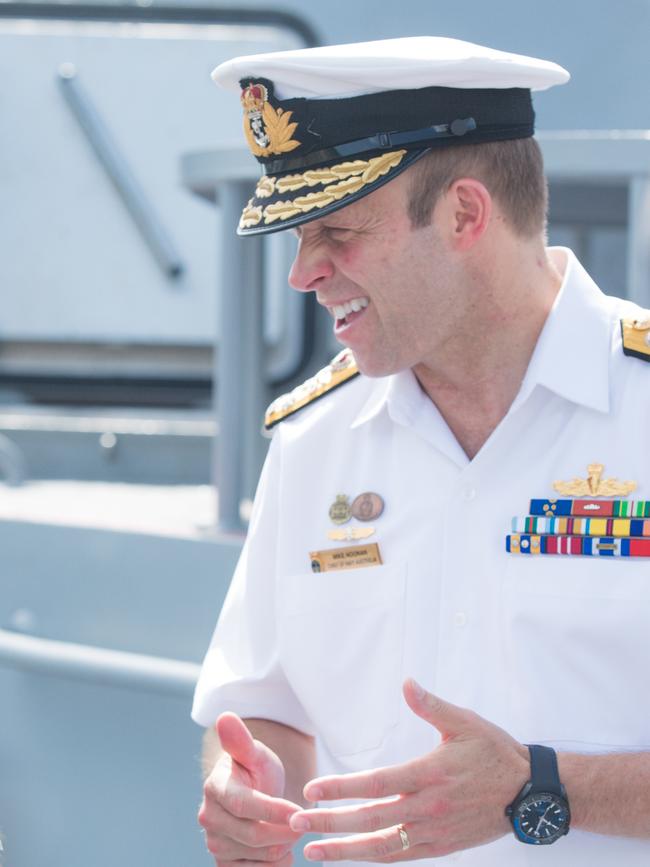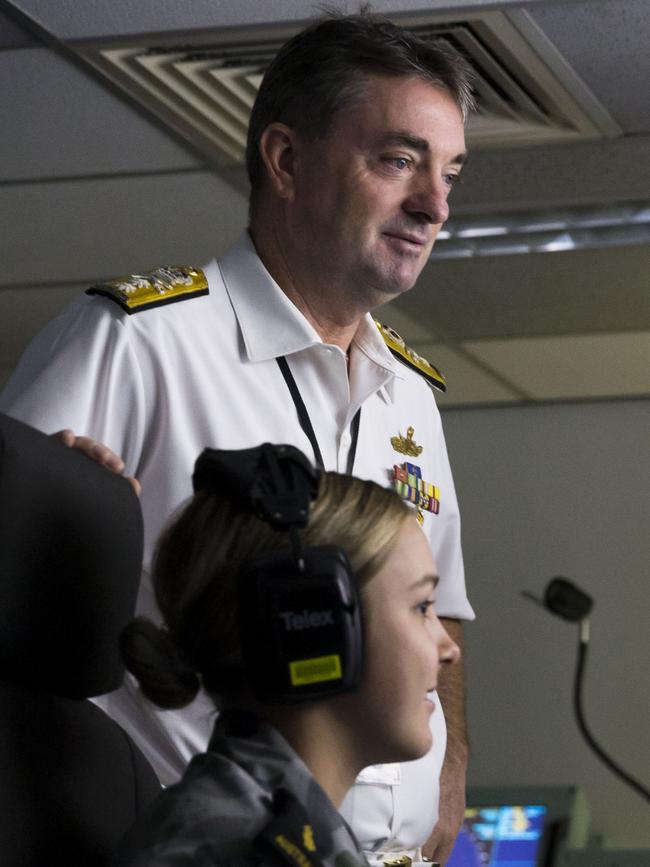Things are getting tense, fast, in Southeast Asia. So much so an Australian admiral says his fleet is now prioritising what is going on to the nation’s north over its Middle East responsibilities.
The Australian Strategic Policy Institute (ASPI) has spoken with the chief of the Royal Australian Navy (RAN), Vice Admiral Michael Noonan, on his thoughts regarding regional security.
And he’s made his concerns clear.
RELATED: Australian writer detained in Beijing
“We as a country — and I as the chief of the navy — are very concerned about the change in dynamic that we see in our region in terms of the observance of international law around maritime boundaries,” Noonan told the think tank’s The Strategist publication.
“We need to be prepared to deter aggression if it does threaten our national interests and, if necessary, take defensive action”, Noonan says. “That’s very, very clear.”
He says that while Australia has never left the region, it now had a more dedicated focus upon it - while maintaining friendly ties with China.
HMAS Melbourne visited Zhanjiang, as did the RAN’s fleed commander. Vice Admiral Noonan has been invited to visit China next year, and his Chinese counterpart to come to Australia. But he says his repositioning of priorities is to offer Canberra options when it comes to defending the national interest.
FORCE RE-BALANCE

“Our government’s focus on the role that Australia plays in the Southwest Pacific has deepened significantly in recent times,” Vice Admiral Noonan told The Strategist . “The one thing that I’m really driving in our navy is that we’ve got to be very agile, we’ve got to be able to make decisions, and ultimately my role is to produce a lethal fighting force, so that if the government needs to use it, we can use it.”
The RAN often has between five and 10 ships operating in international waters, ranging from the Persian Gulf and the Red Sea in the west through to the United States in the east.
Australia’s navy is currently undergoing its largest modernisation program since World War II. Some $90 billion is being spent on new equipment — including the Hunter Class frigates and Attack Class submarines.
Commander of the Australian Fleet Rear Admiral Jonathan Mead told defence publication Defence Connect earlier this month that the navy was undergoing a fundamental shift “not just from a construction and capability perspective, but actually, the way Defence operates”.
RELATED: Does Australia’s new frigate have a fighting chance?

He said the navy had, following the 2015 Department of Defence First Principles Review and the 2016 Defence White Paper, embraced a new ‘battle ready and deployed’ doctrine:
“It means being in the southwest Pacific, southeast, northeast Asia are really our areas of primary operating interests, and that’s what we’re heading for. It’s what 2018 was able to achieve. That’s what I’m looking forward to in 2019 and 2020 as well.”
Australia’s re-balance comes amid unsettling changes in the region.
Not only is Beijing’s military increasingly active in South East Asia, but it has also established a permanent presence in the Indian Ocean since 2008.
And this has serious implications for Australia.
More than half of Australia’s exports depart West Australian ports. And the waters to the nation’s northwest harbour significant oil and gas reserves.
Foreign Minister Marise Payne attended a conference in New Delhi earlier this month which discussed the increasing militarisation of the Indian Ocean. “None of us wants to see confrontation become the dominant shaper of US-China relations,” she said, adding that “the peaceful and open character of the (Indian) ocean is a vital national interest for Australia”.
RISING DRAGON
China’s navy, in particular, is in the midst of a rapid expansion program. In just the past five years, it has launched 80 new warships. Its international power projection capabilities are also expanding. For example, it has been aggressively pursuing a program to establish its own aircraft-carrier centred battle groups.
“I think we all have a very clear view of the changing nature of military capabilities in the region. The military capability China is now building in all three domains is very significant. It changes the level of competition,” Vice Admiral Noonan told ASPI.
Their motivation remains unclear, he added.
But Beijing’s actions speak louder than words.
“We’ve seen over the last 10 years the creation of artificial structures, artificial islands, artificial bases that have by nature of their geography seen China then generate a (new) maritime boundary, which is inconsistent with international law … They continue to take this action, so that means that freedoms of navigation that once existed for this country and the rest of the international community have now been altered in a way that is not consistent with international law”.
RELATED: Ex Aussie defence chief warns we’re ‘sleepwalking’ into war
Since beginning the construction of its controversial artificial islands in 2015, China has insisted the structures were for civilian purposes such as search and rescue. Senior Communist Party officials have also repeatedly promised these would not be militarised.
However, even commercially available satellite photos of the now completed construction work revealed military grade runways, underground munitions bunkers, hardened structures and weapons emplacements. Extensive communications and radar networks have also been installed, far beyond what would be necessary for civilian use.
All that remains is for Beijing to deploy its combat jets and warships to these poorly disguised island fortresses to seize control of the surrounding shipping lanes and air routes.
GROWING REACH
Beijing appears to be already lifting its eyes beyond the South China Sea, which many international affairs analysts consider to be a lost cause already.
It’s beginning to focus attention on what it calls its ‘second island chain’ of national interest. And, in recent months, China’s survey ships have been observed carefully charting these regions.
Trouble is, those islands belong to Japan, the United States, the Federated States of Micronesia and Papua New Guinea.
“Wars and conflicts never start on Fifth Avenue, they start in places of limited strategic consequence [such as the Mariana Islands],” Centre for Strategic and International Studies fellow Patrick Gerard Buchan told the South China Morning Post. “That is where great powers rub up against each other.”
RELATED: Beijing’s island-grabbing campaign gets close to home
And the fear that islands such as Japan’s Okinawa, United States’ Guam and Papua New Guinea’s Manus will become the focus of new territorial disputes is growing.
“It is around these islands that the line of spheres of influence between the [US and China] are being drawn,” said Lyle Goldstein, director of the China Maritime Studies Institute at the US Naval War College. “The question is where does the line switch.”
It's a potential threat the US, Japan and Australia have become increasingly aware of.
Japan has embarked on the largest expansion of its armed forces since the end of World War II. The United States has begun positioning additional forces on Guam. And Australia and the US have both engaged in a project to restore the old World War II naval base on Papua New Guinea’s Manus Island to operational status.
TERRITORIAL GRAB
Australia has made its opposition to China’s claim to the South China Sea clearly known. Like the United States and United Kingdom, it refuses to recognise Beijing’s arbitrary new territorial boundaries.
The US and UK, however, have actively been demonstrating their opposition by deliberately sending their warships through waters that have been open to them since the end of World War II. They’re called Freedom of Navigation Operations (FONOPs).
Beijing has reacted angrily to these challenges, cancelling mutual defence ties and engaged in a heated exchange of escalating rhetoric.
But Vice Admiral Noonan says where the US goes, Australia does not necessarily follow.
“We do not conduct FONOPs in the ADF”, Noonan told ASPI. “It doesn’t mean that we won’t in the future. It doesn’t mean that we shouldn’t. Ultimately, they’re decisions for government to make.”
This, however, does not mean Australia will not maintain a military presence in the region.
It just means RAN warships will not challenge the unrecognised 22km ‘national sovereignty’ claim imposed by Beijing upon its controversial artificial island fortresses.
This puts Australia in a useful diplomatic position, he says.
“We enjoy a level of contact with the Chinese people and the People’s Liberation Army Navy that allows us to continue to have an open dialogue about the international rules-based order … It’s important that we talk so that if we get to a point where we have disagreements, and it could lead to an escalation of tensions in the region or at sea, I have a pathway to have a dialogue with my counterpart.”
And that threat of escalation only keeps growing.
EXPLORE MORE: How China’s building the ultimate dystopia
“Our naval forces have fought together in major engagements against Japan in World War II, which saw many ships lost and thousands of seamen killed who paid the ultimate price in the name of our shared freedom,” he writes. “ Our navies have also engaged in combined operations in multiple war zones since, including Korea, Vietnam, and the Gulf ...”
But he warns against joining “the cheer squad” against China.
“In terms of the stability of the US-China relationship, freedom of navigation operations in the South China Sea are likely to become more confrontational. The accumulated risks, therefore, of collision between aircraft or naval are also likely to become greater. Crisis management between Beijing and Washington may be tested to the limits.”
FIGHTING WORDS
Earlier this month, Senior Captain Zhang Junshe of China’s naval academy told a briefing of international journalists that Beijing was considering the further fortification of its artificial islands because of ‘provocative’ FONOPs.
“Both countries warships definitely have to come into proximity, and it’s easy for there to be a misunderstanding or an error of judgment, even a collision,” he said. “If there is a collision, the root cause is the United States.”
Beijing would not back down on its claim to the contested waterway, he said:
“If our on-island personnel and installations come under threat in future, then we necessarily will take measures to boost our defensive capabilities”.
RELATED: Can the US military continue to ‘contain’ China?
The same briefing was also told by People’s Liberation Army Lieutenant General He Lei that the construction of further bases in the Pacific and the Indian Ocean would not be ruled out.
He added any ‘foreign forces’ that got in the way with China’s ‘unification’ with Taiwan would result in Beijing resorting to military force.
“Foreign forces that pose as world police to interfere in China’s affairs, to obstruct and damage China’s unification, are the main culprits that could force the mainland to use force to resolve the Taiwan issue,” he said.

Add your comment to this story
To join the conversation, please log in. Don't have an account? Register
Join the conversation, you are commenting as Logout
Shock claim as MP’s trial halted
A senior police witness allegedly failed to appear in court on time for Kiama MP Gareth Ward’s criminal trial, instead remarking he was “happy to get arrested”.
Aus ‘realistic’ on China’s influence: Wong
Speaking from Malaysia, the Foreign Minister said China’s attempts to increase its influence in Australia’s backyard “is clear”.